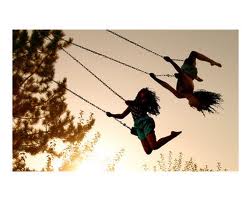Brainwaves
Issue 6, For those who like to rock…
Movement Sensitivity (Part 2, Under-sensitive)
Well the glorious days of summer are almost over and we welcome the cool days of autumn with the smell of harvest in the air and the sound of crickets all around us. This is my favorite time of the year!
The last issue focused on movement over-sensitivity and the folks who prefer to not move too much! I wonder if couch potatoes fall into this category? This issue will focus on people or children who are under-sensitive to movement. They are the ones who NEED to be moving…
Brainwaves is a monthly newsletter designed to create some “brainwaves” within my community of colleagues, friends and clients.
In the last issue, I wrote about folks who dislike excessive movement and don’t the feeling of being too far away from the ground! The brains of people who are movement over-sensitive register they are moving a lot when they are only moving a little. Compare this to the brains of people who are movement under-sensitive…their brain craves movement and register that they are moving a little when they are actually moving a lot!
There are various ideas about why this happens:
- Some researchers believe an under-sensitive movement system explains the movement needs of children that have a diagnosis of hyperactivity…that their vestibular system is under-sensitive.
- Children that have experienced traumatic histories also have a need to move but this may be more as a result of their easily triggered stress response. Their brain interprets something as dangerous (whether it is real or not), and they have a “flight” reaction that looks like a flurry of movement.
- Children with an autism spectrum disorder may have a need to move because they experience a stress response from a sensory situation. For example, if they have over-sensitive hearing and are in a noisy classroom, their brain might cope by telling their body to move excessively ie) rocking, spinning. Rocking, for example, triggers the fluid in the semi-circular canals (discussed in the last issue) and seem to help “drown out” the sound over-sensitivity.
- Another explanation is that excessive movement occurs because of a problem within the visual processing centre of the person. The visual-ocular reflex (VOR) is “…a reflex eye movement that
 stabilizes images on the retina during head movement by producing an eye movement in the direction opposite to head movement, thus preserving the image on the center of the visual field. For example, when the head moves to the right, the eyes move to the left, and vice versa. Since slight head movement is present all the time, the VOR is very important for stabilizing vision: patients whose VOR is impaired find it difficult to read using print, because they cannot stabilize the eyes during small head tremors.” (Wikipedia) An August 2009 research article in the Journal of Pediatrics states that the visual system seems to be more involved in creating balance difficulties in children with attention deficit disorder compared to the somatosensory system or the vestibular system…isn’t that interesting…
stabilizes images on the retina during head movement by producing an eye movement in the direction opposite to head movement, thus preserving the image on the center of the visual field. For example, when the head moves to the right, the eyes move to the left, and vice versa. Since slight head movement is present all the time, the VOR is very important for stabilizing vision: patients whose VOR is impaired find it difficult to read using print, because they cannot stabilize the eyes during small head tremors.” (Wikipedia) An August 2009 research article in the Journal of Pediatrics states that the visual system seems to be more involved in creating balance difficulties in children with attention deficit disorder compared to the somatosensory system or the vestibular system…isn’t that interesting…
So Now What?
- Don’t resist the need for movement! These folks need to move. Dr. John Ratey in his book entitled “Spark” talks about the huge benefits of physical activity…the neurochemicals that are released are like miracle grow for the brain! Remember that just because these folks like to move, don’t assume that they are highly coordinated!
- Remember, if you are short on time, then increase the intensity of the activity but you might need to calm down the nervous system with…
- Heavy muscle work activities will help to calm the body and the mind…climbing, pushing, pulling, carrying…
- Firm pressure on the body from hugs, massage, and compression devices also help the body to feel calmer. This is why some kids like to crawl between and under things!
- These children benefit from sensory integration treatment, vision therapy or an auditory listening program that includes balance and eye tracking activities.
UpcomingWorkshops
Behavior from a Sensation Point of View two Wednesday evenings, October 10 and 17, 2012. Please contact [email protected] for more a workshop brochure.
Rhythmic Movement Training Levels 1 & 2 is available in Calgary November 9-11, 2012. For more information:
http://www.moveplaythrive.com/icalrepeat.detail/2012/08/22/79/
The Attachment Network of Manitoba is very excited to announce that Dr. Dan Siegel will be coming to Winnipeg on November 20, 2012!
http://www.attachmentnetwork.ca/index.php?_a=document&doc_id=31
